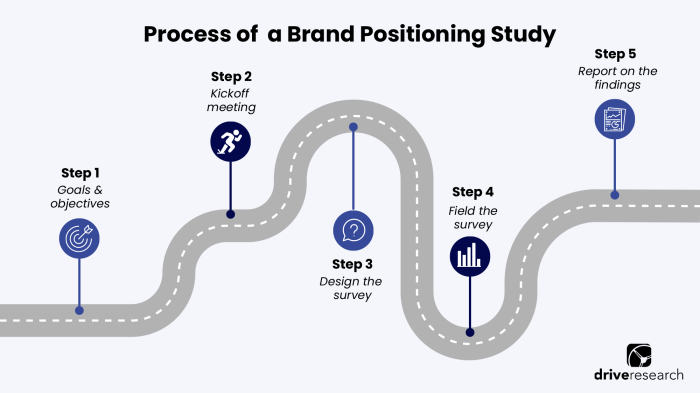Understanding Brand Positioning takes center stage in the world of marketing, where unique strategies shape consumer perceptions and set brands apart. Get ready to dive into the essentials of creating a strong brand identity.
Definition of Brand Positioning

Brand positioning in marketing refers to the strategic process of creating a unique image and identity for a brand in the minds of consumers. It involves differentiating a brand from its competitors and establishing a specific place in the market that resonates with the target audience.
Examples of Brand Positioning Strategies
- Apple: Positions itself as a premium and innovative technology company, focusing on sleek design and cutting-edge features.
- Nike: Positions itself as a brand for athletes and sports enthusiasts, emphasizing performance and empowerment.
- Volvo: Positions itself as a safe and reliable car manufacturer, prioritizing the safety features of its vehicles.
Importance of Brand Positioning
Brand positioning is crucial in influencing consumer perceptions and shaping their attitudes towards a brand. By clearly defining what sets a brand apart from its competitors, it helps create a strong and memorable brand identity. Effective brand positioning can also drive customer loyalty, increase brand awareness, and ultimately lead to increased sales and market share.
Elements of Brand Positioning
Brand positioning is crucial for a company to establish a unique identity in the minds of consumers. There are several key elements that contribute to effective brand positioning, including target market, brand promise, brand personality, and competitive analysis.
Target Market
Identifying the target market is essential for brand positioning as it helps the company understand the needs, preferences, and behaviors of its customers. By focusing on a specific target market, a company can tailor its messaging and offerings to meet the needs of that particular group.
Brand Promise
The brand promise is a statement that communicates what customers can expect from the brand. It should be clear, authentic, and relevant to the target market. A strong brand promise helps build trust and credibility with consumers.
Brand Personality
The brand personality refers to the human characteristics associated with the brand. It helps create an emotional connection with consumers and differentiate the brand from competitors. Whether the brand is seen as sophisticated, playful, or reliable, the brand personality should align with the target market and brand promise.
Competitive Analysis
Conducting a competitive analysis is crucial for understanding the competitive landscape and identifying opportunities for differentiation. By analyzing competitors’ strengths and weaknesses, a company can position its brand in a way that sets it apart from others in the market.
Developing a Brand Positioning Strategy

Developing a brand positioning strategy is crucial for establishing a unique identity in the market and resonating with the target audience. It involves a series of steps to ensure that the brand’s message and values are effectively communicated to consumers.
Identify Target Audience and Market Analysis
To create an effective brand positioning strategy, it is essential to first analyze the target audience and understand the market dynamics. This involves conducting thorough research to identify the demographics, psychographics, and behaviors of the target consumers. By gaining insights into the preferences and needs of the audience, brands can tailor their positioning strategy to effectively communicate with them.
- Conduct market research to identify consumer preferences and trends.
- Analyze competitors to determine their positioning strategies and identify white spaces in the market.
- Identify the unique selling proposition (USP) of the brand that sets it apart from competitors.
- Segment the target audience based on demographics, psychographics, and behaviors.
Examples of Successful Brand Positioning Strategies
Successful brand positioning strategies have a significant impact on consumer behavior and perception of a brand. Let’s take a look at some examples:
Apple’s brand positioning strategy focuses on simplicity, innovation, and user experience. By positioning itself as a premium and cutting-edge technology brand, Apple has successfully created a loyal customer base willing to pay a premium for its products.
Nike’s “Just Do It” campaign is another example of a successful brand positioning strategy. By associating its brand with motivation, empowerment, and athletic performance, Nike has become a leading sports apparel and footwear brand globally.
Coca-Cola’s brand positioning strategy revolves around happiness, togetherness, and nostalgia. Through its emotional marketing campaigns and iconic branding, Coca-Cola has established itself as a timeless and beloved brand across generations.
Communicating Brand Positioning: Understanding Brand Positioning
In order to effectively communicate brand positioning, it is crucial to maintain consistent messaging across all channels. Consistency helps to reinforce the brand’s position in the minds of consumers and build a strong brand identity.
The Importance of Consistent Messaging
Consistent messaging ensures that the brand’s values, personality, and unique selling points are communicated clearly to the target audience. It helps to create a cohesive brand image and build trust with customers. When messaging is inconsistent, it can confuse consumers and dilute the brand’s positioning in the market.
- Utilize the brand’s tone of voice consistently across all communications.
- Ensure that all marketing materials reflect the brand’s positioning accurately.
- Monitor and adjust messaging to maintain consistency over time.
Various Channels and Methods for Communicating Brand Positioning, Understanding Brand Positioning
There are several channels and methods that brands can use to communicate their brand positioning to the target audience. This includes advertising, social media, public relations, events, sponsorships, and influencer partnerships. Each channel offers a unique opportunity to reach consumers and reinforce the brand’s positioning in different ways.
| Advertising: | Utilize creative messaging and visuals to convey the brand’s positioning in traditional and digital advertising campaigns. |
| Social Media: | Engage with followers and share content that aligns with the brand’s positioning to create a strong online presence. |
| Public Relations: | Secure media coverage and partnerships that support the brand’s positioning and values. |
Examples of Brands Effectively Communicating Brand Positioning
– Nike: Through its “Just Do It” campaign, Nike effectively communicates its brand positioning of empowerment and inspiration to athletes and individuals striving for greatness.
– Apple: Apple’s minimalist design and innovative product features reinforce its brand positioning of simplicity, sophistication, and cutting-edge technology.
– Coca-Cola: Coca-Cola’s messaging around happiness, sharing moments, and nostalgia consistently communicates its brand positioning as a refreshing and uplifting beverage choice.





